Moniek Bloks's Blog, page 178
May 31, 2020
The Bonaparte Women: Christine Boyer
Christine Boyer was the first wife of Lucien Bonaparte, the third surviving son of Carlo Bonaparte and his wife Letizia Ramolino and thus the younger brother of Napoleon Bonaparte.
She was born on 3 July 1771 in Saint-Maximin-la-Sainte-Baume in France, the daughter of Pierre André Boyer and Rosalie Fabre. She was the sister of the innkeeper from the inn where Lucien was lodged, and they were married on 4 May 1794. Napoleon was furious when he heard of the marriage and declared that he would never see Christine and never meet with his brother again. Their mother Letizia was also disappointed at the match. However, when Lucien was elected President of the Council of Five Hundred, Napoleon could no longer ignore him. Christine was known to be uneducated, and she could not read or write or even sign her own name. She was also two years older than Lucien.1
Christine and Lucien went on to have four children together: Charlotte (born 28 February 1795), a shortlived son (1796), Victoire Gertrude (1797 – died young) and Christine-Egypta (born 18 October 1798). Letizia eventually grew to like Christine and was “almost as upset” as Lucien at her death.2 Christine died on 14 May 1800 and left a generally good impression.
“Madame Lucien was tall, well-shaped, slender, and had in her figure and carriage that native grace and ease which are imparted by the air and sky of the South; her complexion was dark, she was pitted with the small-pox; her eyes were not large, and her nose was rather broad and flat. In spite of all this she was pleasing because her look was kind, her smile sweet, as well as her voice. She was graceful and good as an angel.”3
Madame Junot, a French writer, said of her “She had in her a profusion of kindness, affection, and love. I knew her, and no sooner knew than loved her. Subsequently, when I have seen her surrounded by the halo of maternal love, new treasures of tenderness manifested themselves in her, and constrained me to love her more and more.”4
“She is said to have been a woman of a mild disposition, amiable manners, and a great goodness of heart. He caused a handsome monument to be erected to her memory, on which is the following simple inscription: – “A daughter – wife – and mother – without reproach!”5
The post The Bonaparte Women: Christine Boyer appeared first on History of Royal Women.
May 30, 2020
Blood Royal: Dynastic Politics in Medieval Europe by Robert Bartlett Book Review
With a focus on medieval Europe, Blood Royal by Robert Bartlett takes on the system of monarchies and how families were shapes by births, marriages and deaths. Monarchies were the essence of medieval Europe.
It is an in-depth look at the way monarchy works, and I was delighted to find that the book did not solely focus on the United Kingdom. The research can only be described as meticulous as about a third of the book’s pages are for the many, many sources. This book would have worked well, but I found it quite dry, and after a while, I was flipping through to the next chapter hoping it would be a little bit more enticing.
Overall, it is an excellent reference work but not quite suitable for the casual reader.
Blood Royal: Dynastic Politics in Medieval Europe by Robert Bartlett will be released on 31 August 2020 in the US and on 9 July 2020 in the UK.
The post Blood Royal: Dynastic Politics in Medieval Europe by Robert Bartlett Book Review appeared first on History of Royal Women.
May 29, 2020
Januária of Brazil – The Emperor’s sister (Part two)
In 1843, Francisca became the first of the siblings to marry. On 1 May 1843, she married Prince François, Prince of Joinville and two weeks later, the happy couple sailed to France to begin their new life. Pedro’s marriage to Teresa Cristina of the Two Sicilies was arranged, though the couple had only seen portraits of each other. They were married by proxy on 30 May 1843 and she travelled to Brazil with her younger brother, Prince Louis of the Two Sicilies, Count of Aquila. Upon their first meeting, Pedro was apparently disgusted with her looks and she knew it, breaking down in tears to her lady-in-waiting. It took hours to convince him that he could not repudiate her and they were wed in person on 4 September 1843.
Though her brother’s marriage was off to a rocky start, Prince Louis made a good impression on Januária and Pedro. According to the constitution, Januária could not leave Brazil until Pedro had children and so her marriage was perhaps quite as important as his. Pedro also valued Louis’ company like a brother he never had. The new Empress could have only been too happy at having a familiar face nearby. By the time Prince Louis left in October, the union between Januária and Louis was practically agreed upon and he returned the following April with a marriage treaty in his hand. On 28 April 1844, Januária and Louis were married. For some reason, the relationship between Pedro and Louis deteriorated rapidly and by the middle of July, they were no longer on speaking terms. In September, Januária and Louis were excluded from the Imperial couple’s first wedding anniversary celebrations. Once when Pedro refused to accompany his wife, sister and brother-in-law to a ball, Louis said, “Well, we are going to dance, and we leave you in your convent.”1 Pedro began to see his new brother-in-law as a threat.
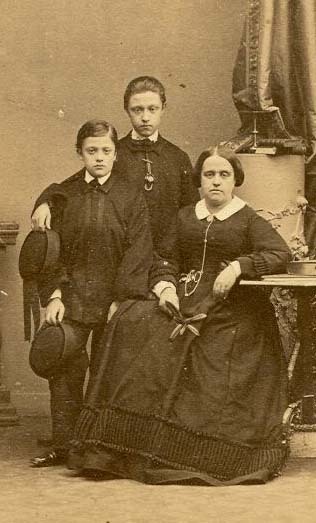 Januária and her two sons (public domain)
Januária and her two sons (public domain)Louis resented his treatment and began to repeatedly request a leave of absence, despite Januária being unable to leave. After a quarrel at a banquet, Louis wanted to leave with or without authorisation. Pedro hastily granted his request to avoid a scandal and on 23 October 1844, Januária and Louis sailed from Rio de Janeiro. They would never see Brazil again but they did maintain a correspondence with Pedro. Their quarrel was eventually resolved. On 23 February 1845, Teresa Cristina gave birth to the short-lived Prince Afonso, and Januária was no longer the heiress presumptive to the throne. She and Pedro would eventually have two surviving daughters, including Isabel, Princess Imperial. Januária herself gave birth to her first child – Prince Luigi, Count of Roccaguglielma – on 18 July 1845. Several more children followed: Maria Isabella (22 July 1846 – 14 February 1859), Filippo (12 August 1847 – 9 July 1922), stillborn twins (1848), Maria Emanuele (24 January 1851 – 26 January 1851).
The family settled in the Kingdom of the Two Sicilies until the King was overthrown in 1860 and the Kingdom was annexed by the new Kingdom of Italy. Januária and Louis began to divide their time between France and England. He turned out to be quite the spendthrift and they eventually drifted apart, living separate lives. Although Januária never would see Brazil again, her brother’s exile in 1889 meant that she would see him again. Teresa Cristina died shortly after their arrival in Portugal but Januária had not been there when they arrived or when the Empress died. She saw him again when he was settled in Cannes and visited him several times. When he spent some time at Versailles and Paris, he also spent time with Januária who also happened to be in Paris. Pedro died on 5 December 1891 and Januária was not with him.
Januária was widowed on 5 March 1897, though it probably affected her little as they had been living separate lives for so long. She survived him for four years, dying on 13 March 1901 – just two days after her 79th birthday – in Nice. Her two surviving children both made unequal marriages. Her eldest son Luigi gave her two grandchildren: Maria (born 1870) and Luigi (born 1873) and she still has living descendants. She was buried at the Pere Lachaise Cemetery in Paris.2
The post Januária of Brazil – The Emperor’s sister (Part two) appeared first on History of Royal Women.
May 28, 2020
Januária of Brazil – The Emperor’s sister (Part one)
Princess Januária of Brazil was born on 11 March 1822 as the second daughter of Pedro I of Brazil and IV of Portugal and his first wife, Archduchess Maria Leopoldina of Austria. She was born at the Imperial Palace of São Cristóvão in Rio de Janeiro. Her elder sister Maria became Queen of Portugal in her own right. Two elder brothers died in infancy, as did a younger sister named Paula. She had a younger sister named Francisca and her younger brother named Pedro succeeded their father as Emperor of Brazil. From her father’s second marriage, she also had a half-sister named Maria Amélia. She also had several illegitimate half-siblings.
The family and the court moved between three residences: the Imperial Palace of São Cristóvão, the Palace da Cidade and the palace on the fazenda (estate) of Santa Cruz. In 1824, Frei Antônio de Arrábida, her father’s confessor, was named as the director of studies for Januária and her sisters. A strict schedule was also adhered to: they were to rise at 7 in the morning and to go to bed no later than half-past eight, meals were taken at 8 in the morning, at noon and at 7 in the evening. Lessons were in the morning and exercise was in the afternoon. Maria, Januária, Paula and Francisca lived apart from their brother, who was the heir to the throne. Nevertheless, they were considered to be close but they were always expected to be deferential to him.
In March 1826, Pedro I also succeeded his father as King of Portugal but a union of the crown of Portugal and Brazil was not acceptable to either nation. And so, on 2 May 1826, he abdicated the Portuguese throne in favour of his eldest daughter Maria, who was just seven years old. Maria received her own establishment within the palace. Maria was also betrothed to her uncle Miguel who would act as regent. However, Miguel pretended to accept this but once he was declared regent, he deposed Maria and declared himself King. Januária was just four years old when her mother died shortly after suffering a miscarriage at the end of 1826. Maria left for Gibraltar in 1828 but she would not see her throne restored to her until 1834.
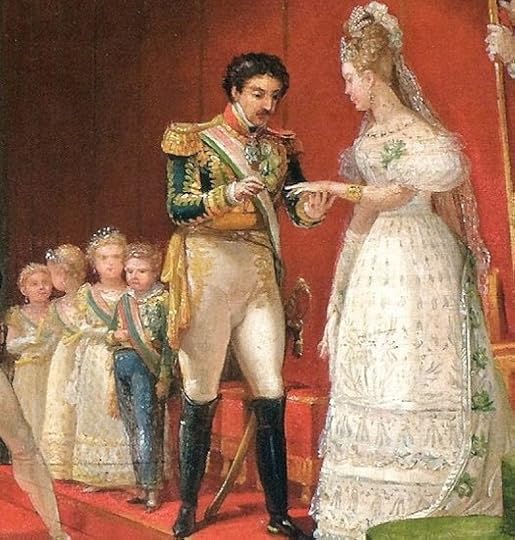 The Emperor’s second marriage. Behind the Emperor are his children by order of precedence: Pedro, Januária, Paula and Francisca. (public domain)
The Emperor’s second marriage. Behind the Emperor are his children by order of precedence: Pedro, Januária, Paula and Francisca. (public domain)In 1829, their father remarried to Amélie of Leuchtenberg and Maria accompanied her new stepmother to Rio de Janeiro, arriving on 16 October. In the early hours of 7 April 1831, Pedro I abdicated the imperial crown of Brazil in favour of his young son Pedro II and immediately travelled to Europe with Maria and his second wife, to support his daughter’s rights. He took the title of Duke of Braganza and became regent in her name. He left behind four sleeping children – including the new 5-year-old Emperor. The following day, a scared and devastated Pedro wrote, “When I got up and could not find Y.I.M. and Mama in order to kiss your hand, I could not contain myself and I still cannot. My dear father, I beg Y.I.M. never to forget this your child who will always show obedience, respect and love for the best of fathers so early lost to your child respectfully kisses your august hands.”1 Originally written in pencil, he only managed the first line in pen before bursting into tears. After his proclamation and the appointment of three regents for the young Emperor, life continued much as it did before for him and his three sisters. However, the siblings were left without their father and stepmother.
Tragedy struck once more in early 1833 when Paula, who had been sickly since her early years, became ill with meningitis or malaria. After three weeks of agony, during which she was treated with quinine both orally and anally, was stuffed with soups and had leeches, mustard plaster and burning chemicals applied to her skin, she died on 16 January 1833 at the age of 9.2 The siblings were devastated at the loss of Paula. In addition, this left only Januária and Francisca as their brother’s heirs. In 1834, their father died in Lisbon of tuberculosis. The siblings’ first instinct was to seek out each other, showing their strong bond.
As they grew up and Pedro became more aware of his exalted status, he still treated his sisters with kindness but he did expect them to do what he wanted. Their close relationship also meant they had little contact with the outside world and Pedro was especially noted for his lack of social skills. Januária and Francisca were probably no different. In 1835, their elder sister Maria was officially excluded from the Brazilian line of succession and Januária became heiress presumptive to her brother. The following year, she declared an oath and became the Princess Imperial of Brazil, a title she held until the birth of her nephew Prince Afonso in 1845.3
Part two coming soon.
The post Januária of Brazil – The Emperor’s sister (Part one) appeared first on History of Royal Women.
May 27, 2020
The Year of Queen Wilhelmina – Wilhelmina’s first official duty
How does one introduce a child to royal life, especially one who is already a Queen in her own right?
 By Richardkw – Own work, CC BY-SA 3.0 via Wikimedia Commons
By Richardkw – Own work, CC BY-SA 3.0 via Wikimedia CommonsQueen Wilhelmina was just ten years old when she performed her first official duty. On 28 May 1891, Wilhelmina laid the foundation stone of a new hospital in Amsterdam, called the Wilhelmina Gasthuis. The weather was apparently awful, and the organisation was chaotic. When the hospital later celebrated its 75th anniversary, a bronze statue of the 10-year-old Wilhelma, made by Mari Andriessen, was placed at the entrance. When it stopped being a hospital in 1983, the statue was moved to Academic Medical Center in Amsterdam. The old Wilhelmina Gasthuis currently consists of offices and apartments.
Shortly after the visit to Amsterdam, Queen Wilhelmina and her mother received an official visit from Emperor Wilhelm II of Germany and his wife Augusta Victoria of Schleswig-Holstein. Wilhelmina later wrote in her memoirs, “On this occasion, I had to act as hostess to the Empress, at home as well as in public. She was very kind and motherly. We followed Mother and the Kaiser in a red carriage. I also had to attend the official banquet. The days of the visit were rich in new experiences for me.”1
Over the next two years, the young Queen laid two more foundation stones in Rotterdam and Utrecht. In June 1892, Wilhelmina also visited the capitals of the northern provinces of Friesland and Groningen. In Friesland, Wilhelmina was shown the meagre meals that a labourer survived on. During visits to Brabant and Twente, she visited textile factories and learned of the circumstances the labourers had to work in.
Wilhelmina later wrote in her memoirs, “Soon we began to pay official visits to towns and provinces, always arranged so as not to interfere with my lessons. At first, these duties frightened me, not at the moment itself but before. I became highly wrought-up about them, with the result that in spite of my perfect health I looked pale and tired during these visits, and gave the public the impression of being a weak child, which made Mother unhappy. I soon got used to the public appearances themselves; Mother made things easy for me.”2
The post The Year of Queen Wilhelmina – Wilhelmina’s first official duty appeared first on History of Royal Women.
May 26, 2020
Anne, Princess Royal – A colourful and hardworking royal
At 11.50 o’clock this morning Her Royal Highness The Princess Elizabeth, Duchess of
Edinburgh, was safely delivered of a Princess at Clarence House.
Her Majesty The QUEEN and His Royal Highness The Duke of Edinburgh were present.
Her Royal Highness and her daughter are both doing well.
The happy event has been commemorated by the firing of the Park and Tower guns1
Princess Anne is often lauded as the hardest-working member of the British royal family, quite deservedly so. Anne was born on 15 August 1950 at 11.50 A.M. as the second child and eldest daughter of the then Princess Elizabeth, Duchess of Edinburgh and the Duke of Edinburgh. Thus, for the first two years of her life, she was known as Princess Anne of Edinburgh. She was born at Clarence House with newspapers announcing her birth weight at six pounds. At the time of her birth, she was third in the line of succession; behind her mother and her elder brother.
She was baptised Anne Elizabeth Alice Louise in the Music Room of Buckingham Palace on 21 October 1950. Her godparents were Queen Elizabeth The Queen Mother (then known as The Queen), Princess Margarita of Greece and Denmark, Princess Alice of Battenberg, Louis Mountbatten, 1st Earl Mountbatten of Burma and Andrew Elphinstone. Her mother became Queen on 6 February 1952 and Anne became known as The Princess Anne. She did not attend her mother’s coronation because of her age but was allowed to join the family on the balcony afterwards.
The subsequent births of her younger brothers Andrew and Edward pushed her further down the line of succession as male-preference primogeniture was still in use then. She was under the care of a governess until she enrolled at the Benenden School in 1963. She left Benenden five years later with six GCE O-Levels and two A-Levels.
In 1970, one of her first relationships was with Andrew Parker Bowles, who would later marry Camilla Shand, who as you may know, became the Prince of Wales’ second wife. On 29 May 1973, the engagement of Anne and Mark Phillips was announced. An estimated 500 million people worldwide watched them get married on 14 November 1973 at Westminster Abbey. Her wedding dress was designed by Maureen Baker of the Susan Small label. It was an embroidered Tudor style dress with a high collar and medieval sleeves. The day was declared a special bank holiday, and many people lined the streets. Anne arrived at the abbey in the Glass State Coach, accompanied by her father. The Archbishop of Canterbury conducted the service. Afterwards, they returned to Buckingham Palace for a balcony appearance and a wedding lunch. Their honeymoon was spent on the Royal Yacht Britannia. They went to live at Gatcombe Park.
Anne is known for being an equestrian, and in 1971 she won the individual title at the European Eventing Championship and she went on to become the BBC Sports Personality of the Year. She continued to compete for several more years and won a silver medal in both the individual and the team event at 1975 European Eventing Championship. In 1976, she participated in the 1976 Montreal Olympic Games.
On 20 March 1974, a rather scary event took place as Anne and Mark were returning to Buckingham Palace. Their car was forced to stop on the Mall and the driver of the other car, Ian Ball, jumped out and fired a weapon. Anne’s personal protection officer jumped out of the car to disarm Ball, but he was shot as his own gun jammed as was Anne’s driver. A nearby journalist who tried to intervene was also shot in the chest. Ball then approached Anne and told her he intended to kidnap her and demand a ransom. Anne replied, “Not bloody likely!” She managed to exit the other side of the car and Ball was hit on the back of the head by a passing pedestrian. Ball wasn’t about to give up, and he shot a Police Constable who happened upon the scene. He was finally arrested by police backup. All those who were shot recovered from their wounds. Ball pleaded guilty to attempted murder and kidnapping, and he is still (as of 2020) detained under the Mental Health Act.
On 15 November 1977, Anne gave birth to her first child – a son named Peter. As Peter is a grandson of The Queen through the female line, he does not have a royal title. A daughter named Zara was born on 15 May 1981. Their marriage soon deteriorated and in 1985 Mark fathered an illegitimate daughter. On 31 August 1989, they announced the intention to separate and initially said they had no plans for a divorce. However, they were eventually divorced on 23 April 1992.
Anne met her future second husband, Timothy Laurence, during her marriage to Mark. He was serving on the Royal Yacht Brittania. They were married on 12 December 1992 in Scotland as the Church of England did not allow divorced people whose former spouses were still living to remarry at the time. For her second wedding, Anne wore a white jacket over a knee-length dress. She also wore flowers in her hair. The newlyweds initially lived in a flat in London before moving to an apartment at St James’s Palace.
Anne undertakes numerous royal duties on behalf of her mother. She is involved with over 200 organisations, and her charity work takes her all over the world. You can read more about all the organisations she is involved with here. On 13 June 1987, Anne was created Princess Royal and is the seventh woman to carry the title. On 23 April 1994, she became Royal Knight of the Most Noble Order of the Garter, and for her 50th birthday in 2000, she became an Extra Knight of the Most Ancient and Most Noble Order of the Thistle. She is currently 14th in the line of succession.
The post Anne, Princess Royal – A colourful and hardworking royal appeared first on History of Royal Women.
May 25, 2020
The Great Series Review – A comedy in corsets
SPOILER ALERT
The Great promises to be a comedy loosely based on the life of Catherine the Great. When they say loosely, they mean it. Within the first 15 minutes, Catherine is married to Emperor Peter III of Russia (in reality – they married in 1745 during the reign of his aunt Empress Elizabeth of Russia). Elizabeth is still present, though as some forgotten aunt who worships her sister Anna – Peter’s mother – and strangely… butterflies. Anna was never Empress as portrayed in The Great, but she was Duchess Consort of Holstein-Gottorp – and died shortly after giving birth to Peter. Bizarrely, her body is on display for the entire court to see and in one particular episode is even used for necrophilia. Are you keeping up? The first episode ends with Catherine’s maid prophetically telling her that if there is no heir, “it” goes to the Empress. Tragically, the errors keep piling up to the point where it’s basically all fiction and has nothing to do with the actual Catherine the Great. Just throw in a made-up Empress and Emperor, it all comes out the same.
So forget everything you know about Catherine the Great and just enjoy this for what it is – a comedy in corsets. The ladies of the court treat Catherine with absolute disdain and are always dressed over the top, with Catherine herself appearing in rather bland and plain colours. She even has the door slammed in her face by a so-called lady. Her servant Marial – she apparently only has one – is a petulant child who also treats her like garbage but is occasionally on her side.
Catherine desperately tries to bring some enlightenment to the Russian court with Peter bringing in the comedic hook. She convinces him to bring scientists to court – he resorts to throwing Marial’s dog off the balcony with a parachute on its back. The printing press is introduced, but both are horrified to find themselves the subject of mocking pamphlets. She then tries to introduce variolation (the forerunner of vaccination) after one of her servants is quarantined in a wardrobe with smallpox. Meanwhile, they occasionally have intercourse or “heir-making” as it is later called with all their clothes on as Catherine’s lover mopes about.
By episode 8, we’re introduced to King Hugo and Queen Agnes of Sweden, as if we needed more fake characters to tell us what a complete fiction this is. We’ve also returned to Catherine’s plotting to stage a coup as an earlier attempt was abandoned when Peter miraculously recovered from being poisoned with arsenic. Also, we’ve completely forgotten about Catherine’s attempts to bring enlightenment. When she suddenly finds herself pregnant by the last episode, her final act begins, and she takes a class in how to become a murderer. Catherine also finally finds the one bright pink dress she owns.
Naturally, the whole plan (if there ever was a solid plan…) goes awry when Marial betrays her, Catherine’s lover is captured, and Catherine suddenly finds herself with a knife to her throat. Throw in a random Voltaire, and the party is complete. In the end, we get there as Catherine sacrifices her lover for the good of Russia with a single tear rolling down her face.
Is there anything to like? Sure, I liked Elle Fanning’s portrayal of a naive Princess thrust into the dangers of the bizarre Russian court but I’d rather they would have just stayed away from the Catherine the Great referencing at all. It serves absolutely no purpose here.
The post The Great Series Review – A comedy in corsets appeared first on History of Royal Women.
May 24, 2020
The Bonaparte Women: Justine Percoli-Suárez
Justine Percoli-Suárez was born on 27 November 1811 in Florence as the daughter of Bernard Percoli and Julie Niccolini. Her first marriage was to Marquess Luigi Bartolini-Baldelli, but she was widowed at an unknown date, leaving her a wealthy widow.
In 1840, she married Jérôme Bonaparte, former King of Westphalia, in a religious ceremony. He had previously been married to Elizabeth Patterson and Catharina of Württemberg. A second (secret) civil ceremony took place on 19 February 1853. Her money helped to alleviate some of his financial troubles, but the marriage was considered to be morganatic, and he continued to call her Madame la Marquise. She agreed to this at first, but she would later insist on being recognised.
She moved to France with him in 1847 where they joined his son from his second marriage, Napoléon-Jérôme. Her stepson took an intense dislike to her and tried to alienate her from his father. Jérôme eventually took a mistress and sent Justine back to Florence.
Justine was widowed in 1860, and she was awarded a pension by Napoleon III. She outlived her husband for many years, dying on 30 January 1903.
The post The Bonaparte Women: Justine Percoli-Suárez appeared first on History of Royal Women.
May 23, 2020
The Year of Queen Wilhelmina – Wilhelmina speaks on the radio
On 13 May 1940, Queen Wilhelmina escaped from the invading German troops and travelled on the HMS Hereward to England. Later that day, Queen Wilhelmina arrived at Harwich, where the British authorities had already arranged for a train to London. Wilhelmina wrote, “At the station, I was met by King George and by my children, who were very upset and did not understand that I should have had to follow them so soon. The King asked me to be the guest of himself and the Queen, and escorted me to Buckingham Palace.”1
The following day, she issued another proclamation telling the people that the government had to be moved abroad. “Do not despair. Do everything that is possible for you to do in the country’s best interest. We shall do our best. Long live the fatherland!”2
On 24 May, Wilhelmina spoke on the radio for the first time during the war. She spoke to the Dutch overseas citizens, saying “Firstly, a word of thanks for your sympathies with the unmentionable suffering that has befallen our motherland so undeservedly and which reached its pinnacle with the occupation of our land in Europe despite the fierce resistance by our military forces supported by the coldbloodedness of our people. Their remarkable courage and determination in the most difficult of circumstances have earned them the admiration of friend and foe. Despite the experienced setback, my trust in the future remains unaltered. Our people have known troubled times before which they have overcome with their trust in God and their wish to be free. This is why I am giving you these words of encouragement. Nor my people, nor my ministers, nor I have in these dark days doubted what our duty commands. And we shall be calm and courageous, trusting in the justice in our cause. We shall all rise above the events of the moment because we follow the mainline of a great principle, the only ones who are powerful and confident and who bring along that they fight against injustice.
“Then now a word of confidence for you all overseas. For centuries we have been together, and from that, we have bonds of appreciation and affection, so strong that they, in these heavy days, are helping to support us. Our constitution has made the overseas lands to an unbreakable unit, and it is my satisfaction to say that these are not empty words. You have given this a meaning, so deep and rich, that alone is a guarantee for a better future, resting on the unity of the realm, which has remained so strong and alive. The call for help on the Dutch East Indies from the motherland has been answered by all layers of the society of the Dutch East Indies, and great sums of money have been made available to me. I thank them, from the name of the motherland, that we will never forget how the people of the Dutch East Indies have to the aide of their overseas brothers.
“Our tricolour, a symbol of peace, order, safety and enforcing the law, even for the least and the weakest, will wave proudly over the largest part of the realm. With God’s help, this will remain this way until the end of days. Gather around the Governor, support him with his heavy task, move aside your difference and be of one mind because you should remember that it is about the preservation and the salvation of the Kingdom. My thoughts are with you.”3
The following day, she also addressed listeners in the United States and the United Kingdom. From July, the BBC broadcasted Radio Oranje (Orange) where Wilhelmina spoke 34 times over the course of the war to encourage the Dutch people. It was illegal for the Dutch people to listen to the broadcasts and many did so in secret. King George VI was most impressed by Wilhelmina, calling her “a remarkable woman and wonderfully courageous.”4 Winston Churchill described her as the only real man in all the governments in exile in London.5
The post The Year of Queen Wilhelmina – Wilhelmina speaks on the radio appeared first on History of Royal Women.
May 22, 2020
Book News June 2020
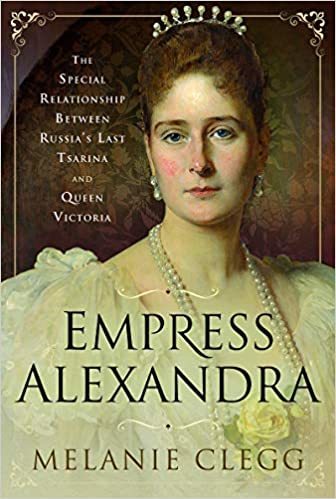
Empress Alexandra: The Special Relationship Between Russia’s Last Tsarina and Queen Victoria
Hardcover – 30 June 2020 (UK) & 3 October 2020 (US)
When Queen Victoria’s second daughter Princess Alice married the Prince Louis of Hesse and Rhine in 1862 even her own mother described the ceremony as more of a funeral than a wedding’ thanks to the fact that it took place shortly after the death of Alice’s beloved father Prince Albert. Sadly, the young princess’ misfortunes didn’t end there and when she also died prematurely, her four motherless daughters were taken under the wing of their formidable grandmother, Victoria. Alix, the youngest of Alice’s daughters and allegedly one of the most beautiful princesses in Europe, was a special favourite of the elderly queen, who hoped that she would marry her cousin Prince Albert Victor, Duke of Clarence and one day reign beside him as Queen. However, the spirited and stubborn Alix had other ideas.
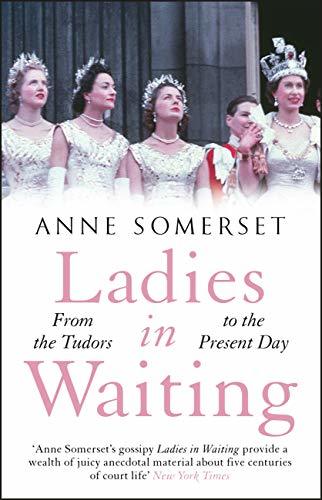
Ladies in Waiting: a history of court life from the Tudors to the present day
Paperback – 25 June 2020 (UK)
For centuries, the most beautiful, able and aristocratic women in England competed for positions at court. Some who came to serve were remarkable for their learning and exemplary virtue, but others were notable for promiscuity and lack of scruple, drawn to court by a lust for money and power. Several ladies-in-waiting became royal mistresses, showing few qualms about betraying the queen consorts they ostensibly served. If bedding the King was not an option open to all, many ladies came to court in hope of finding husbands, only to succumb to constant assaults on their virtue or to find themselves denied permission by their sovereign to marry.
Drawing on an enormous variety of sources, Anne Somerset provides an illuminating guide to the character, profligate or pious, of each court.
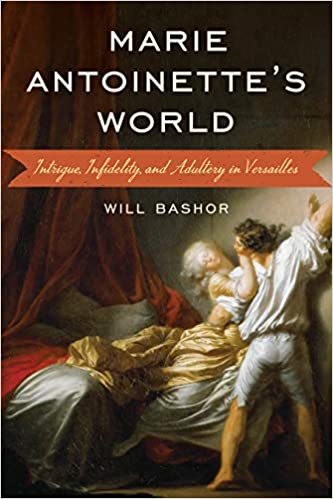
Marie Antoinette’s World: Intrigue, Infidelity, and Adultery in Versailles
Hardcover – 15 June 2020 (US) & 1 August 2020 (UK)
This riveting book explores the little-known intimate life of Marie Antoinette and her milieu in a world filled with intrigue, infidelity, adultery, and sexually transmitted diseases. Will Bashor reveals the intrigue and debauchery of the Bourbon kings from Louis XIII to Louis XV, which were closely intertwined with the expansion of Versailles from a simple hunting lodge to a luxurious and intricately ordered palace. It soon became a retreat for scandalous conspiracies and rendezvous—all hidden from the public eye. When Marie Antoinette arrived, she was quickly drawn into a true viper’s nest, encouraged by her imprudent entourage. Bashor shows that her often thoughtless, fantasy-driven, and notorious antics were inevitable given her family history and the alluring influences that surrounded her. Marie Antoinette’s frivolous and flamboyant lifestyle prompted a torrent of scathing pamphlets, and Bashor scrutinizes the queen’s world to discover what was false, what was possible, and what, although shocking, was most probably true.
Readers will be fascinated by this glimpse behind the decorative screens to learn the secret language of the queen’s fan and explore the dark passageways and staircases of endless intrigue at Versailles.
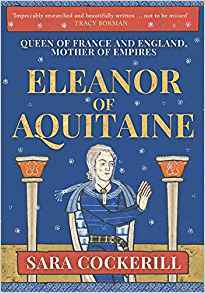
Eleanor of Aquitaine: Queen of France and England, Mother of Empires
Hardcover – 15 November 2019 (UK) & 1 June 2020 (US)
In the competition for remarkable queens, Eleanor of Aquitaine tends to win. In fact, her story sometimes seems so extreme it ought to be made up.
The headlines: orphaned as a child, duchess in her own right, Queen of FranceC crusader, survivor of a terrible battle, kidnapped by her own husband, captured by pirates, divorced for barrenness, Countess of Anjou, Queen of England, mother of at least five sons and three daughters, supporter of her sons’ rebellion against her own husband, his prisoner for fifteen years, ruler of England in her own right, traveller across the Pyrenees and Alps in winter in her late sixties and seventies, and mentor to the most remarkable queen medieval France was to know (her own granddaughter, obviously).
It might be thought that this material would need no embroidery. But the reality is that Eleanor of Aquitaine s life has been subjected to successive reinventions over the years, with the facts usually losing the battle with speculation and wishful thinking.
In this biography, Sara Cockerill has gone back to the primary sources and the wealth of recent first-rate scholarship, and assessed which of the claims about Eleanor can be sustained on the evidence. The result is a complete re-evaluation of this remarkable woman s even more remarkable life. A number of oft-repeated myths are debunked and a fresh vision of Eleanor emerges. In addition, the book includes the fruits of her own research, breaking new ground on Eleanor s relationship with the Church, her artistic patronage and her relationships with all of her children, including her family by her first marriage.
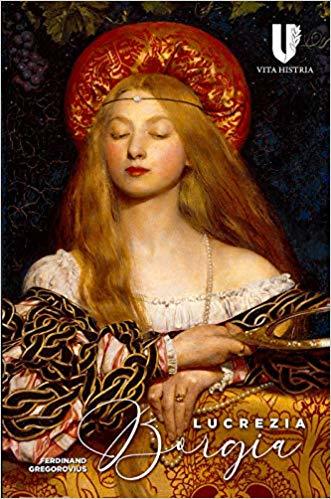
Lucrezia Borgia: Daughter of Pope Alexander VI (Vita Histria)
Hardcover – 1 May 2020 (UK) & 2 June 2020 (US)
Lucrezia Borgia is among the most fascinating and controversial personalities of the Renaissance. The daughter of Pope Alexander VI, she was intensely involved in the political life of Italy during the late fifteenth and early sixteenth centuries. While her marriage alliances helped advance the political objectives of the papacy, she also held the office of Governor of Spoleto, a role normally reserved for Cardinals, making her one of the most powerful and dynamic female figures of the Renaissance. Among the first books to employ historical method to move beyond myth and romance that had obscured the fascinating story of Lucrezia Borgia was the biography written by the noted German historian Ferdinand Gregorovius. Ferdinand Gregorovius (1821-1891) was one of the preeminent scholars of the Italian Renaissance. His biography of Lucrezia Borgia reveals the atmosphere of the Renaissance, painting a portrait of Lucrezia and her relationships with her father Rodrigo Borgia, Pope Alexander VI, her brother Cesare, her mother Vanozza, her father’s mistress, Giulia Farnese, her husband Duke Alfonso D’Este of Ferrara, and many others, including important artists and writers of the time. All are vividly portrayed against the colorful background of Renaissance Italy. Gregorovius separates myth from documented fact and his book remains a key reference work on the life and times of the Borgia princess.

Empress Galla Placidia and the Fall of the Roman Empire
Paperback – 27 June 2020 (US) & 30 July 2020 (UK)
Despite being one of history’s most important women, the story of Galla Placidia’s life has been largely forgotten. Though the Roman empress witnessed the decline and fall of the Roman Empire in the 5th century and lived a life of almost constant suffering, her actions helped postpone the fall of Rome and had massive, widespread impact on the empire that can still be felt today. She watched the barbarian king Alaric and his horde of Visigoth warriors sack Rome, slaughter many of the city’s inhabitants, and take her hostage. Surviving captivity, Galla Placidia became the queen of the barbarians who had imprisoned her. Eventually, she became the only woman to rule the Roman empire alone. Soldiers obeyed her commands while Popes and Christian saints alike sought her advice. Despite all obstacles and likely suffering from PTSD, she lived to old age. This book uses the letters and writings of Galla Placidia’s contemporaries to reconstruct, in more depth and detail than has yet been attempted, the remarkable story of her life and the decline and fall of the Roman Empire.
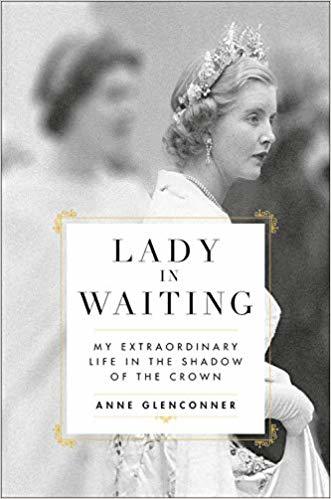
Lady in Waiting: My Extraordinary Life in the Shadow of the Crown
Paperback – 25 June 2020 (UK)
Anne Glenconner has been close to the Royal Family since childhood. Eldest child of the 5th Earl of Leicester, she was, as a daughter, described as ‘the greatest disappointment’ by her family as she was unable to inherit. Her childhood home Holkham Hall is one of the grandest estates in England. Bordering Sandringham the Princesses Elizabeth and Margaret were frequent playmates.
From Maid of Honour at the Queen’s Coronation to Lady in Waiting to Princess Margaret, Lady Glenconner is a unique witness to royal history, as well as an extraordinary survivor of a generation of aristocratic women trapped without inheritance and burdened with social expectations.
She married the charismatic but highly volatile Colin Tennant, Lord Glenconner, who became the owner of Mustique. Together they turned the island into a paradise for the rich and famous, including Mick Jagger and David Bowie, and it became a favourite retreat for Princess Margaret.
But beneath the glitz and glamour there has also lurked tragedy. On Lord Glenconner’s death in 2010 he left his fortune to a former employee. And of their five children, two grown-up sons died, while a third son had to be nursed back from a coma by Anne, after having suffered a near fatal accident.
Anne Glenconner writes with extraordinary wit, generosity and courage and she exposes what life was like in her gilded cage, revealing the role of her great friendship with Princess Margaret, and the freedom she can now finally enjoy in later life. She will appear as a character in the new series of The Crown this autumn.
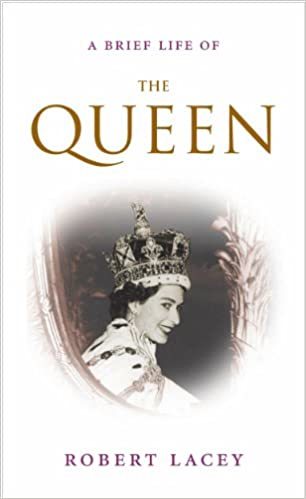
Brief Life of the Queen
Paperback – 11 June 2020 (UK)
The finest short life of the monarch, by the ‘founding father’ of contemporary royal biography fully updated to within a month of publication. For more than thirty-five years Robert Lacey has been gathering stories from the members of the Queen’s inner circle – her friends, relatives, private secretaries and former prime ministers – and the results are distilled in this elegant hardback. Tracing her life through its major stages, and uncovering her greatest personal loves and trials, A Brief Life of the Queen offers the freshness of the first-hand insights and compelling storytelling for which Robert Lacey’s bestselling biographies are renowned. A succinct, personal and beautifully illustrated biography of Elizabeth II, who has managed to remain an enigma, despite being the most recognised woman in the world. AUTHOR: Robert Lacey is a British historian noted for his in-depth research and page-turning narrative style. He is the author of several international bestsellers including Majesty, The Kingdom: Arabia and the House of Saud and Great Tales from English History. He is the historical consultant to the award-winning Netflix series The Crown, and author of The Official Companion to the Crown.
The post Book News June 2020 appeared first on History of Royal Women.



